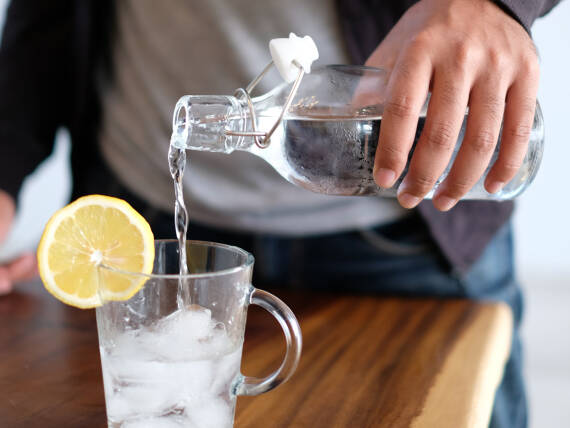Reverse osmosis for the purest water
The reverseosmosis system: pure water from the kitchen tap
Pure water to drink and cook with at all times. You cannot make compromises when it comes to the health of you and your loved ones. A reverseosmosis system filters all kinds of contaminants out of your drinking water. Find out all you need to know about purchasing a reverseosmosis water filter here.

A water filter in the kitchen is worth it

Tap water is safe for drinking in Singapore. For other markets such as in Germany, tap water has to be tested to assess as drinking-water quality. In some cases, it may still contain numerous contaminants. Ground water can be polluted with residues of pesticides, nitrates and heavy metals. Bacteria and residues from medication can also survive the filtering process at local treatment plants.
A reverse-osmosis system is the most effective filtration system for removing these contaminants from the tap water. With this system, you can be sure you’re drinking and cooking with the purest water.
This water filter uses the principle of reverse osmosis. In nature, osmosis is the natural process in which substances are evenly distributed in water. As the name suggests, reverse osmosis reverses this process: At the core of this system is an extremely thin membrane that only allows water molecules to pass through it. Pre-filters free the tap water of coarse impurities.
Investing in a reverseosmosis system for the water in the kitchen will pay off in more ways than one:
- A water filter in the kitchen can guarantee that your family only consumes the purest water.
- Water filtered through reverse osmosis makes purchasing mineral water redundant, so you save money.
- You are protecting the environment, as there is no need to make, transport or recycle single-use water bottles.
Filtered water improves your quality of life, as you don’t need to haul any more heavy water bottles around.
When it comes to water filtered through reverse osmosis, the devil is in the detail
There is a huge range of this kind of filter, and every system uses the principle of reverse osmosis. So the devil is in the detail. The filters that are fitted will determine the membrane’s shelf life. You should therefore read the manufacturer’s information on the quality of the built-in filters.
The perfect position for the reverse-osmosis water filter
The filter system is usually directly connected to the water and drain connections under the sink. This means the size of the reverse-osmosis water filter plays a key role when choosing a model. In an ideal situation, the device would be installed in the base cabinet under the sink. An additional tap for filtered water would be fitted on your sink basin.
If this is a problem, you can choose a model without a direct water connection. This counter-top system does not require any installation: You simply need to fill the device regularly and dispose of the filtered waste water.
Water tank or direct flow?
They come with a water tank or as direct flow. A system with a tank filters the water and stores it. The benefit: You can draw water without having to wait. The water taken out of the system is immediately replaced. This means stagnant and fresh water are mixed. To avoid a build-up of germs, the tank needs to be emptied on a regular basis. A system with a tank also requires much more space.
Direct-flow systems only filter the water when it is actually needed. A booster pump transports the water through a very high-performance membrane here. But this means you have to wait a little bit. Depending on the efficiency, it can take a few minutes for a litre of water to be filtered. So please refer to the manufacturer’s information to find out the system’s speed.
Important: automatic flushing and waste water
It is important that all reverse-osmosis systems are regularly flushed, as this cleans the filters. We therefore recommend selecting a model with an automatic flush.
You should also note the ratio of filtered water to waste water. Modern systems have a ratio of 1:1.
Filters and mineralisation
A good system will have at least one activated carbon filter for pre-cleaning. This extends the membranes’ lifetime, thus reducing the operating costs.
This kind of reverse-osmosis system also filters minerals out of the water. So some manufacturers provide mineralisation cartridges to enrich the filtered water with minerals. However, this is not really necessary for a healthy diet.
The filters and membrane in every system need to be regularly replaced. So before deciding to purchase, please check the ongoing costs that lie ahead.
Frequently asked questions about reverse-osmosis systems
A filter guarantees you are drinking only the purest water with no contaminants, so you will no longer need to buy mineral water. You will also be protecting the environment because no single-use water bottles need to be made, transported or recycled.<br />
Countertop systems do not require installation or connections. However, you will need to manually fill the system and dispose of the waste water.
If the dimensions are suitable, it can be effortlessly installed in the sink’s base cabinet.
The water is always freshly filtered and is not left standing in a tank. However, please note that there is a waiting time.
Modern systems have a ratio of 1:1.
Healthy water from the tap
A reverse-osmosis system in the kitchen reliably filters contaminants out of the tap water. However, the devil is in the detail. A system with a tank needs to be regularly emptied, but the filtered water is immediately available. With a system with a direct connection, you always get freshly filtered water, but you need to wait a while. You also need to be aware of the filter quality and operating costs.Authorised dealers